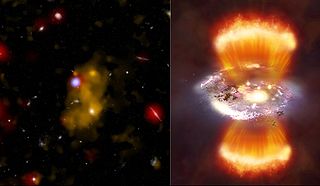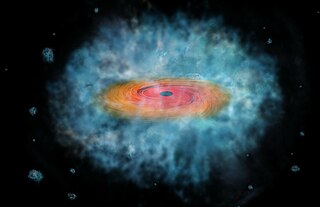
A quasar is an extremely luminous active galactic nucleus (AGN). It is pronounced KWAY-zar, and sometimes known as a quasi-stellar object, abbreviated QSO. This emission from a galaxy nucleus is powered by a supermassive black hole with a mass ranging from millions to tens of billions of solar masses, surrounded by a gaseous accretion disc. Gas in the disc falling towards the black hole heats up because of friction and releases energy in the form of electromagnetic radiation. The radiant energy of quasars is enormous; the most powerful quasars have luminosities thousands of times greater than that of a galaxy such as the Milky Way. Usually, quasars are categorized as a subclass of the more general category of AGN. The redshifts of quasars are of cosmological origin.

In physics, a redshift is an increase in the wavelength, and corresponding decrease in the frequency and photon energy, of electromagnetic radiation. The opposite change, a decrease in wavelength and simultaneous increase in frequency and energy, is known as a negative redshift, or blueshift. The terms derive from the colours red and blue which form the extremes of the visible light spectrum.
In the fields of Big Bang theory and cosmology, reionization is the process that caused matter in the universe to reionize after the lapse of the "dark ages".
Redshift quantization, also referred to as redshift periodicity, redshift discretization, preferred redshifts and redshift-magnitude bands, is the hypothesis that the redshifts of cosmologically distant objects tend to cluster around multiples of some particular value. In standard inflationary cosmological models, the redshift of cosmological bodies is ascribed to the expansion of the universe, with greater redshift indicating greater cosmic distance from the Earth. This is referred to as cosmological redshift. Ruling out errors in measurement or analysis, quantized redshift of cosmological objects would either indicate that they are physically arranged in a quantized pattern around the Earth, or that there is an unknown mechanism for redshift unrelated to cosmic expansion, referred to as "intrinsic redshift" or "non-cosmological redshift".

In astronomy, a Lyman-alpha blob (LAB) is a huge concentration of a gas emitting the Lyman-alpha emission line. LABs are some of the largest known individual objects in the Universe. Some of these gaseous structures are more than 400,000 light years across. So far they have only been found in the high-redshift universe because of the ultraviolet nature of the Lyman-alpha emission line. Since Earth's atmosphere is very effective at filtering out UV photons, the Lyman-alpha photons must be redshifted in order to be transmitted through the atmosphere.

A Lyman-alpha emitter (LAE) is a type of distant galaxy that emits Lyman-alpha radiation from neutral hydrogen.

A Pea galaxy, also referred to as a Pea or Green Pea, might be a type of luminous blue compact galaxy that is undergoing very high rates of star formation. Pea galaxies are so-named because of their small size and greenish appearance in the images taken by the Sloan Digital Sky Survey (SDSS).
Lyman-break galaxies are star-forming galaxies at high redshift that are selected using the differing appearance of the galaxy in several imaging filters due to the position of the Lyman limit. The technique has primarily been used to select galaxies at redshifts of z = 3–4 using ultraviolet and optical filters, but progress in ultraviolet astronomy and in infrared astronomy has allowed the use of this technique at lower and higher redshifts using ultraviolet and near-infrared filters.

UDFy-38135539 is the Hubble Ultra Deep Field (UDF) identifier for a galaxy which was calculated as of October 2010 to have a light travel time of 13.1 billion years with a present proper distance of around 30 billion light-years.

Green bean galaxies (GBGs) are very rare astronomical objects that are thought to be quasar ionization echos. They were discovered by Mischa Schirmer and colleagues R. Diaz, K. Holhjem, N.A. Levenson, and C. Winge. The authors report the discovery of a sample of Seyfert-2 galaxies with ultra-luminous galaxy-wide narrow-line regions (NLRs) at redshifts z=0.2-0.6.

9Spitch is a gravitationally lensed system of two galaxies. The nearer galaxy is approximately 2 billion light-years (610 Mpc) from Earth and is designated SDSS J020941.27+001558.4, while the lensed galaxy is 10 billion light-years (3.1 Gpc) distant and is designated ASW0009io9. It was discovered in January 2014 by Zbigniew "Zbish" Chetnik, an amateur astronomer from Northamptonshire, England, while classifying images on the website Spacewarps.org. The discovery was announced on the BBC television programme Stargazing Live.
In cosmology, intensity mapping is an observational technique for surveying the large-scale structure of the universe by using the integrated radio emission from unresolved gas clouds.

Tololo 1247-232 is a small galaxy at a distance of 652 million light-years. It is situated in the southern equatorial constellation of Hydra. Visually, Tol 1247 appears to be an irregular or possibly a barred spiral galaxy. Tol 1247 is named after the surveys that were carried at the Cerro Tololo Inter-American Observatory (CTIO), the first of which was in 1976. It is one of nine galaxies in the local universe known to emit Lyman continuum photons.

Haro 11 (H11) is a small galaxy at a distance of 300,000,000 light-years (redshift z=0.020598). It is situated in the southern constellation of Sculptor. Visually, it appears to be an irregular galaxy, as the ESO image to the right shows. H11 is named after Guillermo Haro, a Mexican astronomer who first included it in a study published in 1956 about blue galaxies. H11 is a starburst galaxy that has 'super star clusters' within it and is one of nine galaxies in the local universe known to emit Lyman continuum photons (LyC).

Cosmos Redshift 7 is a high-redshift Lyman-alpha emitter galaxy. At a redshift z = 6.6, the galaxy is observed as it was about 800 million years after the Big Bang, during the epoch of reionisation. With a light travel time of 12.9 billion years, it is one of the oldest, most distant galaxies known.

TON 618 is a hyperluminous, broad-absorption-line, radio-loud quasar and Lyman-alpha blob located near the border of the constellations Canes Venatici and Coma Berenices, with the projected comoving distance of approximately 18.2 billion light-years from Earth. It possesses one of the most massive black holes ever found, at 66 billion M☉.

Direct collapse black holes are high-mass black hole seeds, putatively formed within the redshift range , when the Universe was about 100-250 million years old. Unlike seeds formed from the first population of stars (also known as Population III stars), direct collapse black hole seeds are formed by a direct, general relativistic instability. They are very massive, with a typical mass at formation of ~105 M☉. This category of black hole seeds was originally proposed theoretically to alleviate the challenge in building supermassive black holes already at redshift , as numerous observations to date have confirmed.

GLASS-z12 is a candidate Lyman-break galaxy discovered by the Grism Lens-Amplified Survey from Space (GLASS) observing program using the James Webb Space Telescope in July 2022. It is currently one of the earliest and most distant galaxies ever discovered, dating back to just 350 million years after the Big Bang, 13.6 billion years ago.














